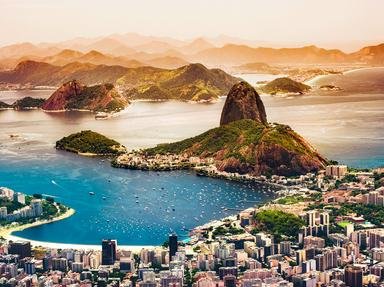Quiz Answer Key and Fun Facts
1. Iguazu Falls is easily one of the most beautiful locations on the planet, with its series of waterfalls (the largest system in the world) following a horseshoe-like row. The falls line the border between Brazil and what other large South American country?
2. Nearly 80% of this region's floodplains are underwater during rainy seasons, and it is home to countless plant and animal species. What is the name of this massive Brazilian wetland?
3. The Meeting of Waters in Manaus, Brazil, is a fascinating look at the confluence between the Solim§es River (part of the Amazon) and the Rio Negro. Due to differences in the content of each body of water, a striking contrast is created. What is the cause of the brown-colored water?
4. Sugarloaf Mountain, at the mouth of Guanabara Bay, is a popular location on which you can take a cable car. In which Brazilian city is it located?
5. The region of JalapŃo, with its orange sand dunes, comprises the second largest hot desert on Earth after the Sahara.
6. A popular locale for tourists, performers, and even athletes, which beach in Rio de Janeiro is flanked by two forts, one at each end?
7. With an elevation of 2,995 meters (9,827 ft) above sea level, Pico de Neblina is taller than Mount Aconcagua in Argentina.
8. Due to the impermeable rock layer covering its base, Lenšˇis Maranhenses National Park is home to a large number of what natural features?
9. Known as "Diamond Plateau" in English, which region was once the world's largest diamond producer?
10. The most common accounting of how the Amazon rainforest got its name is from which of the following, who encountered a tribe of female warriors?
Source: Author
trident
This quiz was reviewed by FunTrivia editor
agony before going online.
Any errors found in FunTrivia content are routinely corrected through our feedback system.
